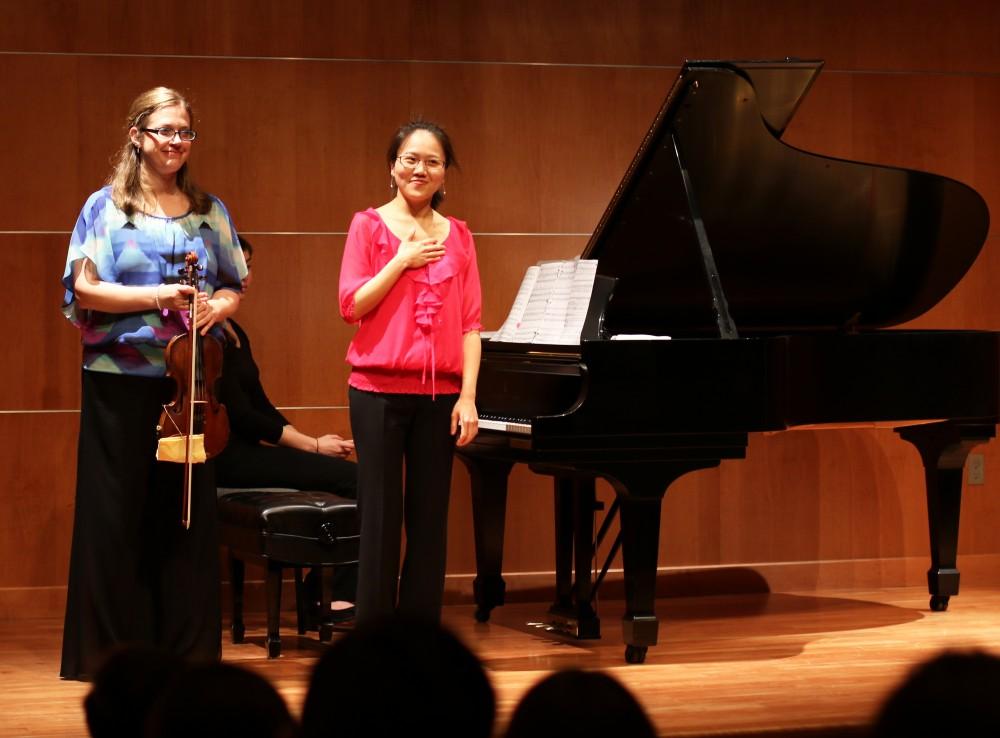Faculty recital delves into emotion, musical storytelling

GVL / Kasey Garvelink – Megan Reiter Crawford (left) and Sookkyung Cho (right) performed together on Mar. 15, 2016 in Allendale.
Mar 21, 2016
While it’s often easy to hear music as a single, entertaining combination of sounds, doing so can make a listener lose the detailed nuances. A recent faculty recital at Grand Valley State University allowed audience members to lose themselves, instead, by exhibiting the important musical combination of synergy, setting and storytelling.
The March 15 recital featured piano professor Sookkyung Cho and violin professor Megan Crawford playing four pieces. From Olivier Messiaen to Camille Saint-Saëns, each piece came from a different French composer.
Despite this, Cho said pieces like the ones she and Crawford played often transcend their composer.
“The emotional experience doesn’t have to be exactly the way the composers experienced it,” Cho said. “That’s how the composer experienced (emotions) writing this piece or before writing this piece, but once the piece is born, it is an entity in itself, and then it speaks to people differently.
“I think just being able to indulge in that emotional world almost purifies our being. You go and experience it, and you come out a different person.”
A member of the Grand Rapids Symphony Orchestra who has performed nationwide, Crawford is currently a visiting professor at GVSU. She said that the musical pairing of violin and piano is common, due to the instruments’ ability to complement each other.
“Violin is a melodic instrument, and the piano fills in the harmony, so you have melody and harmony,” she said. “You get the richness of the harmony the composer has in mind through the piano combination.”
In the recital’s audience was junior piano student Connor Austell. Austell said attending events like Cho and Crawford’s recital is vital for his growth as a musician.
“(Learning as a musician) is really about going to as many live events as you can and picking up on the nuances of the performance that really come across live better than they ever could over recording,” Austell said.
Austell also said he was happy to attend the event in the long-closed Sherman Von Solkema Recital Hall. The hall had to be closed and renovated, after a failure of the hall’s humidification system during winter break ruined its wood paneling.
Crawford said the unique acoustics of a room impact musical performance. She said that the new wall material in the hall gave it a powerful amplification, comparing it to “a living surround sound.”
Cho also said that the specific piano in the Sherman Von Solkema Hall positively contributed to her performing experience.
“That piano is super, uber-sensitive,” she said. “You can really speak to it and it’ll talk back to you. You can really create so many different colors, and the touch is so nice.
“It goes with the hall, it’s like you can whisper and people will still hear it. I loved playing the Debussy in there, because you can really whisper.”
Claude Debussy’s “Beau Soir” was one of two pieces Cho and Crawford performed with a story behind it. Crawford explained to the audience that Debussy’s “Beau Soir” was based off a poem, while Francis Poulenc’s Sonata was an emotional response to poet Federico García Lorca’s death in the Spanish Civil War.
Crawford said that this idea of emotion is paramount for musical performance.
“I think the emotional content is the most important part of the performing experience,” she said. “I try to teach my students, ‘yes, you have to practice the technique…’ but when you’re performing, you move on past that. That’s the entire purpose, is to touch somebody in the audience with the powerful emotion of whatever the piece is.”






















